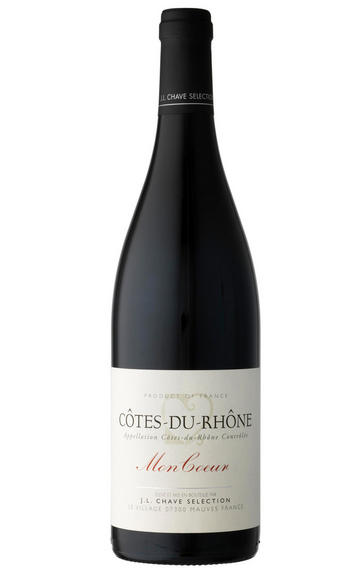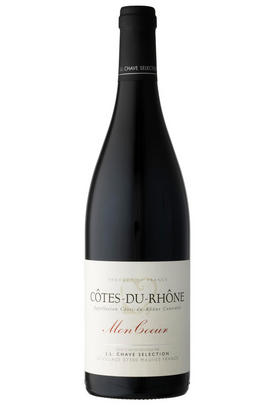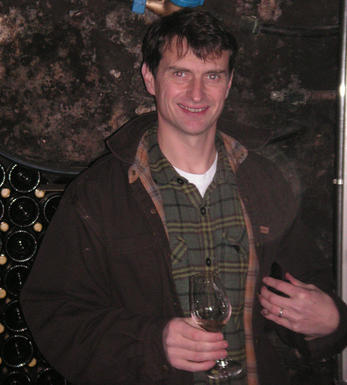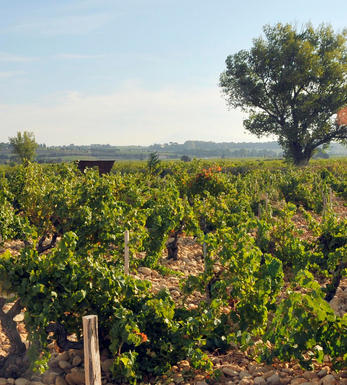
2015 Côtes du Rhône, Mon Coeur, J.L. Chave Sélection, Rhône

Critics reviews
Tar, leather, dark black fruit with delicious leathery character on the finish. Proper fine-grained tannin. Up there with the best of them! An absolute delight and VVGV.
Drink 2018 - 2028
Richard Hemming MW, JancisRobinson.com (February 2018)
This unfurls a pure beam of crushed plum and black cherry fruit, inlaid gently with singed bay leaf, pepper and anise notes. A light smoky edge runs through the finish. Drink now. 9,000 cases made, 4,500 cases imported.
James Molesworth, Wine Spectator (June 2017)
About this WINE

Chave
The Chaves have been growing vines on the famous Hermitage hill for over 500 years. Gérard Chave took over from his father in 1970 and rapidly achieved megastar status due to the extraordinary quality of his wines. The easte is currently under the helm of University of California Davis graduate Jean Louis Chave, although his father Gerard still plays an active role.
The domaine produces a red St Joseph 'Offerus' (made in equal proportions from senior vines in Mauves and St –Jean-de Muzols), an acclaimed Vin de Paille, but their reputation is built on their superb red Hermitage (Syrah with the addtion of 15% white grapes) and white Hermitage (85% Marsanne and 15% Roussanne).
The Chaves own 15 hectares of vines on the Hermitage and crucially their Hermitage holding is spread across 9 of the 18 climates on the hill (incl. Les Bessards, the adjucent Le Méal, Les Roucoles, Maison Blanche and the monopoles L'Hermite and Peléat). This means that they can produce a blend which reflects the separate "terroirs" of the climates and is a perfect balance between aromatic complexity, power and finesse.
The grapes are partially de-stemmed and then fermented in a combination of open wooden vats and cement cuves. The wine is matured in a combination of large wooden foudres and small wooden casks (a proportion of which will be new) for 12-18 months. All Chave wines are bottled unfiltered.
J.L. Chave Sélection is the exclusive négociant label of Jean-Louis Chave, the doyen of Hermitage wine, and offers the perfect solution for those who adore the great wines from this appellation but not the price tag of Chave’s main label.

Côtes du Rhône
Côtes du Rhône, located in southern France’s Rhône Valley, is one of the country’s largest and most well-known wine appellations. The region is renowned for producing a wide range of high-quality wines, with vineyards extending from just south of Lyon in the north to Avignon in the south, covering both banks of the Rhône River.
Côtes du Rhône is celebrated for its wide array of red and white grape varieties. The primary red grape varieties include Grenache, Syrah, Mourvèdre, and Cinsault, while the main white grape varieties consist of Viognier, Marsanne, and Roussanne.
The region is divided into several appellations, each with distinct characteristics and regulations. The hierarchy ranges from the broad Côtes du Rhône appellation to more specific and prestigious sub-appellations like Côtes du Rhône Villages and Crus such as Châteauneuf-du-Pape, Gigondas, and Hermitage.
The region benefits from a diverse terroir, contributing to the different wine styles. The northern part has a continental climate, while the southern portion enjoys a Mediterranean climate, which plays a vital role in grape ripening and flavour development.
The red wines are highly regarded for their rich and robust flavours. They often exhibit notes of dark fruits, herbs, spices, and distinctive peppery quality, especially in the Syrah-dominated wines from the northern Rhône.
The white wines are typically aromatic and elegant, with flavours of stone fruits, floral notes, and hints of mineral complexity.
Côtes du Rhône also produces excellent rosé wines, which are refreshing and perfect for warm weather enjoyment.
Winemaking in Côtes du Rhône has a long history from ancient times. The region preserves a combination of traditional methods and modern techniques, allowing winemakers to express the unique characteristics of their terroir.
Côtes du Rhône wines are versatile and pair well with a wide range of dishes, including roasted meats, hearty stews, grilled vegetables, and cheeses.

Southern Rhône Blend
The vast majority of wines from the Southern Rhône are blends. There are 5 main black varieties, although others are used and the most famous wine of the region, Châteauneuf du Pape, can be made from as many as 13 different varieties. Grenache is the most important grape in the southern Rhône - it contributes alcohol, warmth and gentle juicy fruit and is an ideal base wine in the blend. Plantings of Syrah in the southern Rhône have risen dramatically in the last decade and it is an increasingly important component in blends. It rarely attains the heights that it does in the North but adds colour, backbone, tannins and soft ripe fruit to the blend.
The much-maligned Carignan has been on the retreat recently but is still included in many blends - the best old vines can add colour, body and spicy fruits. Cinsault is also backtracking but, if yields are restricted, can produce moderately well-coloured wines adding pleasant-light fruit to red and rosé blends. Finally, Mourvèdre, a grape from Bandol on the Mediterranean coast, has recently become an increasingly significant component of Southern Rhône blends - it often struggles to ripen fully but can add acidity, ripe spicy berry fruits and hints of tobacco to blends.


Buying options
Add to wishlist
Description
The idea of a Côtes du Rhône from Monsieur Chave was always fascinating; I was intrigued to know where he would source his fruit for such a project. Vinsobres, with its altitude, its high proportion of Syrah and its relatively northern location, provides a significant minority and the other key communes are Cairanne, Séguret and Valréas, all lauded and all tending to eschew more indulgent styles of Grenache. Elegant and aromatic, the outstanding 2015 has a dense textured palate, ripe and fruit-forward and with a pleasing lick of pepper at the finish. Drink now to 2021.
Simon Field MW, Wine Buyer
wine at a glance
Delivery and quality guarantee